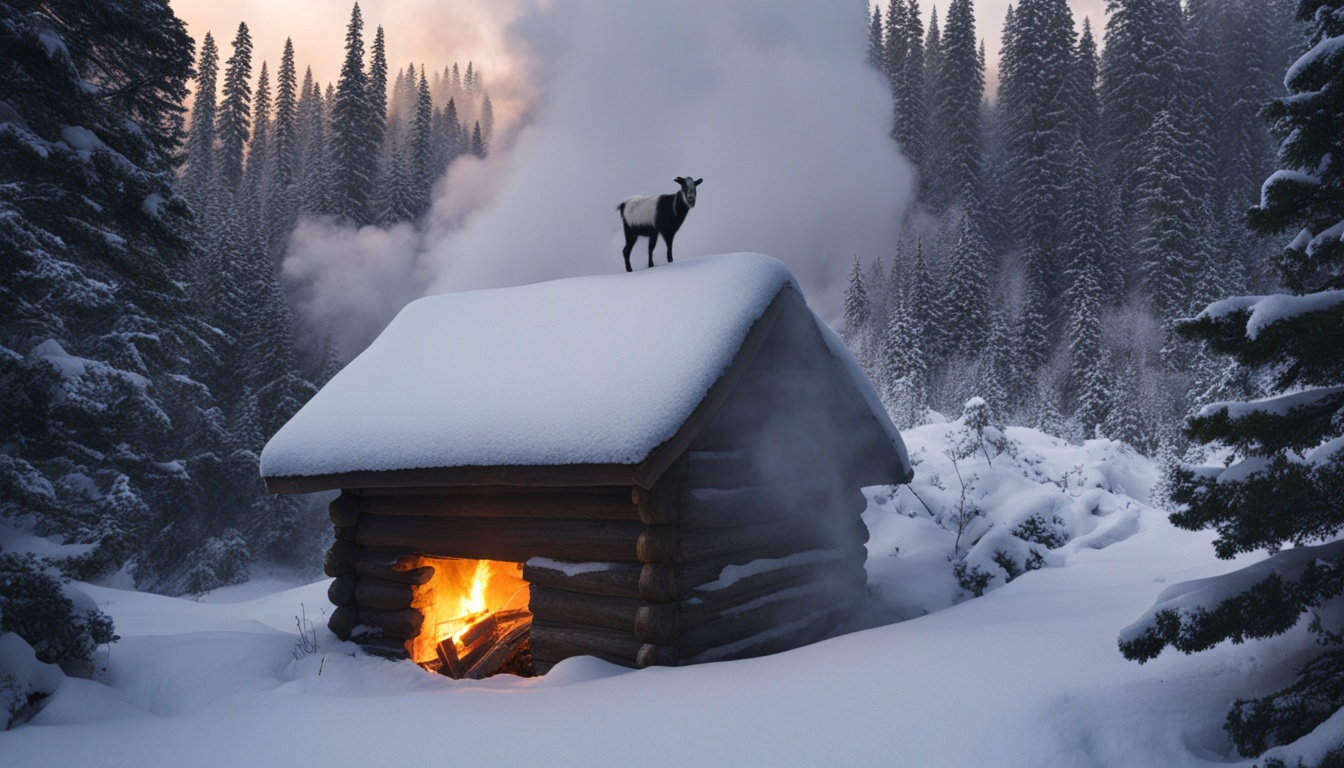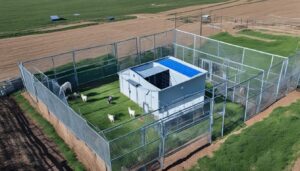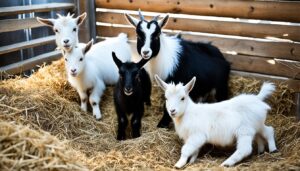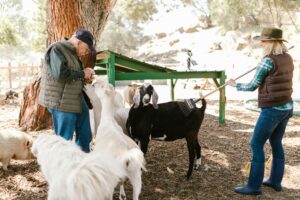When autumn winds begin to whisper, memories of my family’s first pygmy goats flood back. These tough yet lovable creatures stole our hearts. However, I fretted over keeping them snug in our barn. So, I dug deep to find the best ways to shield my new herd from the cold.
Insulating a pygmy goat house is key for their well-being. While these compact goats handle the cold pretty well, they need good goat shelter insulation to stay warm and hearty. In this guide, I’ll spill the beans on pygmy goat housing and small livestock insulation. You’ll learn all you need to know to make sure your livestock barn insulation is top-notch.
This piece will guide you from learning about pygmy goats’ needs to new goat house ventilation methods. You’ll be equipped to insulate your pygmy goat house just right. After reading, you’ll have the skills to craft a snug space for your herd, despite the harsh insulating animal shelters challenges.
Key Takeaways
- Pygmy goats require proper insulation and shelter to stay warm and healthy during the winter months.
- Understand the unique needs of pygmy goats, including their hardiness and cold tolerance, to ensure their comfort.
- Prepare the goat shelter by choosing the right location, assessing the existing structure, and ensuring proper ventilation.
- Explore various insulation options, such as straw bedding, wood shavings, and rigid foam panels, to find the best fit for your needs.
- Combine insulation methods and consider supplemental heating to maintain the ideal temperature in the pygmy goat house.
Understanding the Needs of Pygmy Goats
Pygmy goats originate from West Africa and are known for being hardy, able to cope with cold. They have a thick, double-layered coat that keeps them warm. But, providing a shelter that’s dry and free from drafts is essential. This shelter protects them from cold elements like wind, rain, and snow.
Hardiness and Cold Tolerance
Pygmy goats are tough and handle colder weather well. Their coats are like a warm blanket, keeping body heat in. Thanks to this, they do well in cold places where other goats might not.
Importance of Proper Shelter
Even though they’re hardy, pygmy goats need a snug shelter. A shelter built for them keeps them at the right temperature. This helps avoid illnesses like pneumonia or frostbite. Knowing what pygmy goats need is key to keeping them safe and happy in winter.
Preparing the Pygmy Goat Shelter
When you’re making a shelter for your pygmy goats, there are a few important things to think about. Think about the pygmy goat shelter location, see if the place is already good, and make sure there’s enough air flowing. The shelter must be in a spot that doesn’t get too wet, isn’t in windy areas, and is covered from the bad weather. You can use existing spots like sheds or barns by checking the room and then fixing it up to fit the goats.
Choosing the Right Location
Finding the right pygmy goat shelter location is key. This keeps your goats comfy and safe. Pick a place that drains well and isn’t hit by bad weather often.
Assessing the Existing Structure
If you’re using a spot that’s already there as a goat shelter, you need to look it over well. Check how much room and what changes you might need to do for your goats.
Ensuring Proper Ventilation
Good pygmy goat shelter ventilation means your goats stay healthy. Simply adding windows, vents, or other ways for air to flow is important. This keeps bad gases and too much moisture out.

Insulation Options for Pygmy Goat Houses
When you need to insulate a
pygmy goat house
, you have many options. Straw bedding is a top pick because it keeps the house warm. It also soaks up moisture and feels comfortable for the goats.
Using wood shavings or chips is also smart. These materials keep things dry and cozy. Adding rigid foam panels to walls and roofs helps protect against losing heat. The choice of insulation depends on things like the weather, money, and what you like. Think about what each option does best before you decide.
Straw Bedding
Straw bedding is a favorite for pygmy goats. It keeps them warm and comfy. The air pockets in straw trap heat well, which is great for insulation.
Wood Shavings or Chips
Wood shavings or chips work well too. They keep things dry, which the pygmy goats really need for their health and happiness.
Rigid Foam Insulation
Taking it further, you can add rigid foam panels for more warmth. They stop heat from escaping, creating a snug space for the pygmy goats.
How Should I Insulate a Pygmy Goat House?
Choosing the right insulation for your pygmy goat house is the first step. Then, it’s vital to install it correctly. Loose-fill insulation like cellulose or fiberglass is great for walls and ceilings. Rigid foam insulation can be cut and glued to cover walls and roofs. Mixing these types, using foam as main, and loose-fill for spaces, helps keep your goats cozy.
Applying Loose-Fill Insulation
Cellulose or fiberglass are good loose-fill options for your goat house. They can fill up the small places well, keeping the warmth inside. This method is excellent for reaching every nook and cranny.
Installing Rigid Foam Insulation
Rigid foam, made of polyurethane or polystyrene, is another good choice. You cut it to fit and attach it solidly to walls and ceilings. Its high R-value helps keep your goat shelter warm.
Combining Insulation Methods
Combining rigid foam and loose-fill insulation is best. It’s like creating a warm cocoon for your goats. This way, you balance insulation and air sealing perfectly for your area and shelter.

Keeping the Pygmy Goat House Warm
Adding extra heat alongside good insulation is a key to keeping the pygmy goat house warm. This is especially important in very cold weather. Heat lamps work well but can start fires. Choose safety and try alternative heating options like infrared heaters or heated water buckets to avoid this danger.
Using Heat Lamps Safely
When using heat lamps for your pygmy goats, put safety first. Make sure they’re securely placed and not reachable by your goats. Check the cords and setup for wear often to avoid electrical issues. Also, keep the area well-ventilated to prevent heat from causing problems for your goats.
Exploring Alternative Heating Options
There are alternative heating options that are safer than heat lamps. For example, infrared heaters give off heat directly and don’t have open flames. Heated water buckets also keep water from freezing. Always watch the temperature and airflow with any heating source for pygmy goats.

Getting the right mix of insulation and heat makes a nice home for your herd. With the right heating choices and safety measures, your pygmy goats can stay warm and happy through winter.
Bedding Materials for Insulation and Warmth
Choosing the right bedding for a pygmy goat house is key for keeping it warm.
Many farms use straw for bedding. It’s thick and keeps in body heat well. The way straw is made, with small hollows, makes it so air stays in to warm things up more.
Wood shavings or chips are good too. They soak up moisture. Keeping the space dry helps keep the goats healthy.
Combine straw and wood shavings for the best results. They work well together to make the goat’s home cozy.
Benefits of Straw Bedding
Straw bedding is great for keeping a pygmy goat warm. Its thick layer locks in heat. Plus, the straw’s hollow parts hold onto warm air well, making a snug place for your herd.
Advantages of Wood Shavings
Wood shavings are another top pick. They are absorbent, helping to keep everything dry. A dry spot means the goats are less likely to get sick from too much moisture.

Maintaining Proper Ventilation
Proper ventilation is key in a pygmy goat house, even if it’s insulated well. Good airflow keeps the right temperature, stops harmful gases from building up, and lowers the chance of breathing problems. You can use windows, vents, or openings to let fresh air in without causing drafts.
Importance of Air Flow
Airflow in pygmy goat houses is vital for their health and happiness. It keeps the air moving, preventing stale air that can be full of bad gases and germs. This is why ventilation in pygmy goat houses is a must.
Avoiding Moisture Buildup
Keeping an eye out for moisture buildup is also important. Moisture can cause mold and mildew, which are bad for goat’s lungs. Making sure the place is well-ventilated stops this, keeping your goats happy and healthy in winter.

Insulating for Different Climates
The insulation needs for a pygmy goat house can change with the weather in your area. In colder regions, you’ll want more insulation. Using rigid foam panels and plenty of bedding helps your pygmy goats stay warm and cozy insulating pygmy goat houses for cold regions.
Cold Regions
In places with cold winters, keeping the heat in is key. Using thick insulation is very important. It keeps your pygmy goats nice and warm. Insulating pygmy goat houses for cold regions is essential.
Temperate Regions
For insulating pygmy goat houses in temperate regions, find a good mix of insulation and ventilation. Use different materials and place windows or vents wisely. This keeps the area at a comfortable temperature and well-aired for your pygmy goats.
Warm Regions
If you live in a warmer place, keeping it cool is the challenge. Shade and good airflow are important. Make sure your space is airy and well-ventilated. This helps keep your pygmy goats from getting too hot in insulated pygmy goat houses for warm regions.
Know your local climate to best care for your pygmy goats. Tailor the insulation and ventilation to where you live. This keeps your pygmy goats happy and healthy all year round.

Additional Tips for Insulating Pygmy Goat Houses
There are extra steps you can take to keep pygmy goat houses cozy. Sealing drafts and cracks is key. It’s important to find and close any gaps or holes. This can stop heat from escaping and keep a steady temperature for your goats. Using radiant barrier insulation is also smart. This type of insulation reflects heat. Rather than absorbing it, it keeps warmth inside, making your goat house more efficient.
Sealing Drafts and Cracks
Finding and sealing up drafts and cracks is crucial. This helps keep the interior warm and well-insulated. It makes a big difference in how comfy and energy-efficient the house is, especially in cold weather.
Considering Radiant Barrier Insulation
Radiant barrier insulation is a good addition for warmth. It reflects heat, stopping it from leaving. Adding this type of insulation, with others or alone, improves your goat house’s energy efficiency.

Common Mistakes to Avoid
When you’re insulating a pygmy goat house, watch out for some common errors. These mistakes can make insulation less effective or harm your goat’s health. Knowing what to avoid helps keep your pygmy goats cozy and safe in winter.
Overheating the Shelter
Heating the pygmy goat shelter too much is a big mistake. This can happen with too much insulation or using heaters the wrong way. Pygmy goats are good in the cold, but too much heat stresses them. It’s key to keep the right balance so they’re comfortable.
Neglecting Ventilation
Ventilation is very important for your goat’s house. Without it, bad gases and too much moisture can build up. This bad air can cause breathing problems for your goats. Making sure air can flow in and out well is vital for their health.
Using Unsuitable Insulation Materials
Using the wrong insulation materials is a big no-no. Some can catch fire or release harmful gases. You need to pick insulation that’s safe and works well for animal shelters. Do your homework to find the right materials for your goat’s house.

Keep in mind these problems and take steps to fix them. This will make a great home for your pygmy goats. They’ll be happy and healthy, even when it’s cold outside.
Conclusion
Properly insulating a pygmy goat house is key for their comfort and health. You should know what pygmy goats need, fix their shelter, choose the best insulation, and ensure good ventilation. Doing this makes a warm, safe place for your goats, even in winter.
Think about the weather, your budget, and keeping the goats safe when you choose insulation. It’s important to avoid mistakes. With the right steps, your pygmy goats will be happy and cozy. Follow this guide to give them the perfect winter home, even in very cold places.
Need more help with winterizing your pygmy goat house? Check out this article from Morning Chores. It offers detailed advice on caring for pygmy goats in winter. This will help keep your herd healthy and joyful all year.
FAQ
How can I insulate a pygmy goat house effectively?
To insulate a pygmy goat house well, use methods like straw bedding and rigid foam panels. Ventilation is key too. This keeps the goats comfy and healthy.
What are the specific needs of pygmy goats that should be considered when insulating their shelter?
Pygmy goats handle cold well, but they need a shelter to stay dry and warm. Insulation keeps them healthy, avoiding issues like pneumonia and frostbite.
How should I prepare the pygmy goat shelter before insulating it?
Start by picking a well-drained spot. Check the shelter’s structure and add ventilation if needed. This means windows, vents, or openings for fresh air.
What are the best insulation options for a pygmy goat house?
Good insulation choices include straw bedding and rigid foam. They keep the house dry and help with warmth. Wood shavings or chips are good too.
How should I properly install insulation in a pygmy goat house?
For the best insulation, choose loose-fill types like cellulose. It can go in walls and ceilings easily. Rigid foam can also be used with adhesive or fasteners.
What are some ways to keep the pygmy goat house warm during the winter?
Heat lamps or infrared heaters help in winter. Make sure to keep an eye on the temperature and air circulation. This ensures the goats are comfortable.
How can the type of bedding used in the pygmy goat house contribute to insulation and warmth?
Straw and wood shavings trap heat and keep the house warm. They also absorb moisture, making sure the goats stay healthy.
Why is proper ventilation important in a pygmy goat house, even when it is well-insulated?
Good ventilation keeps the air fresh and the temperature right. It prevents harmful gases from building up and helps avoid breathing problems.
How do insulation requirements vary for pygmy goat houses in different climates?
The insulation needed changes with the climate. Cold areas require more insulation and bedding. In warmer places, focus on ventilation and shade.
What are some common mistakes to avoid when insulating a pygmy goat house?
Avoid making the shelter too hot, not ventilating enough, and using harmful insulation. These mistakes can be bad for the goats’ health.



